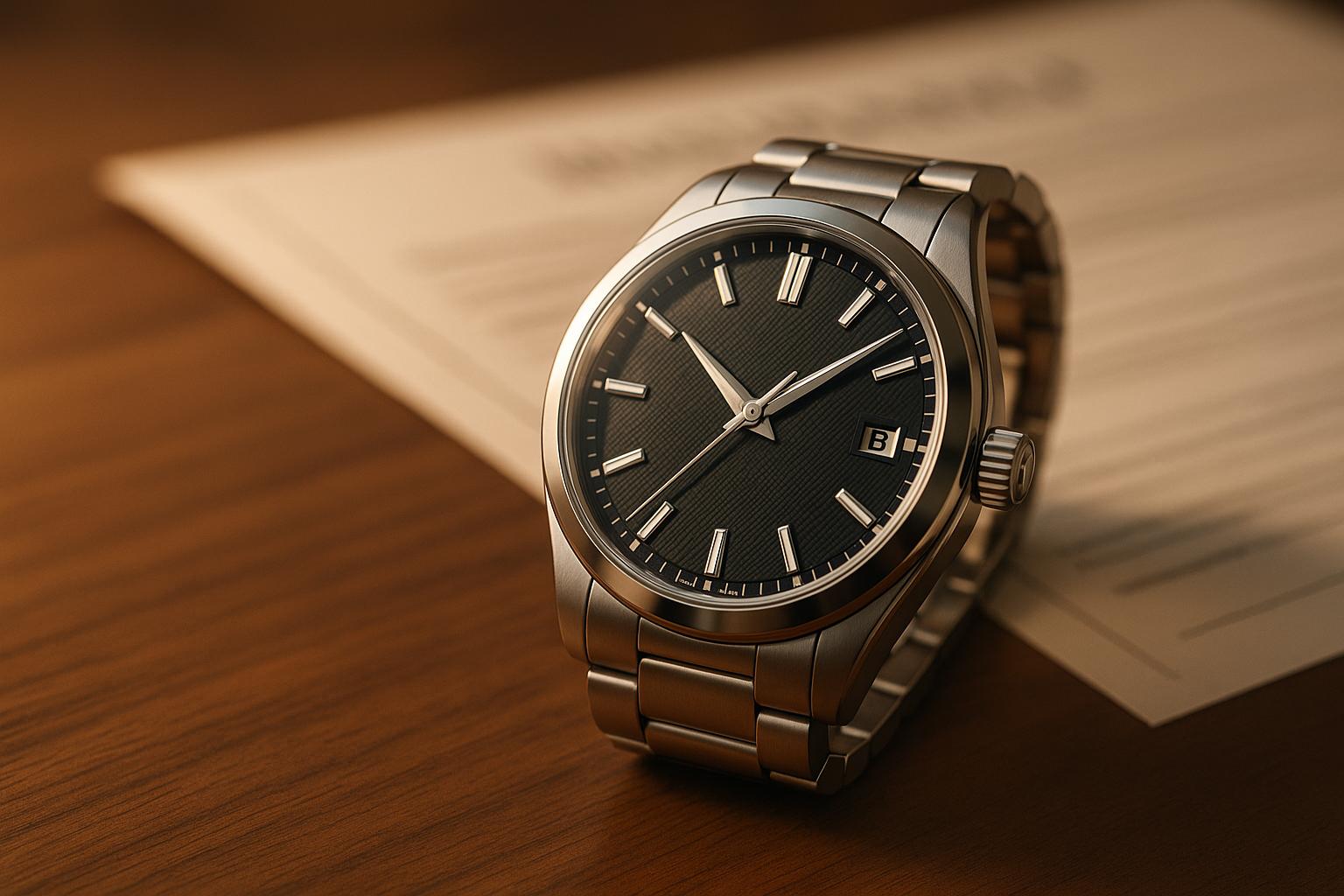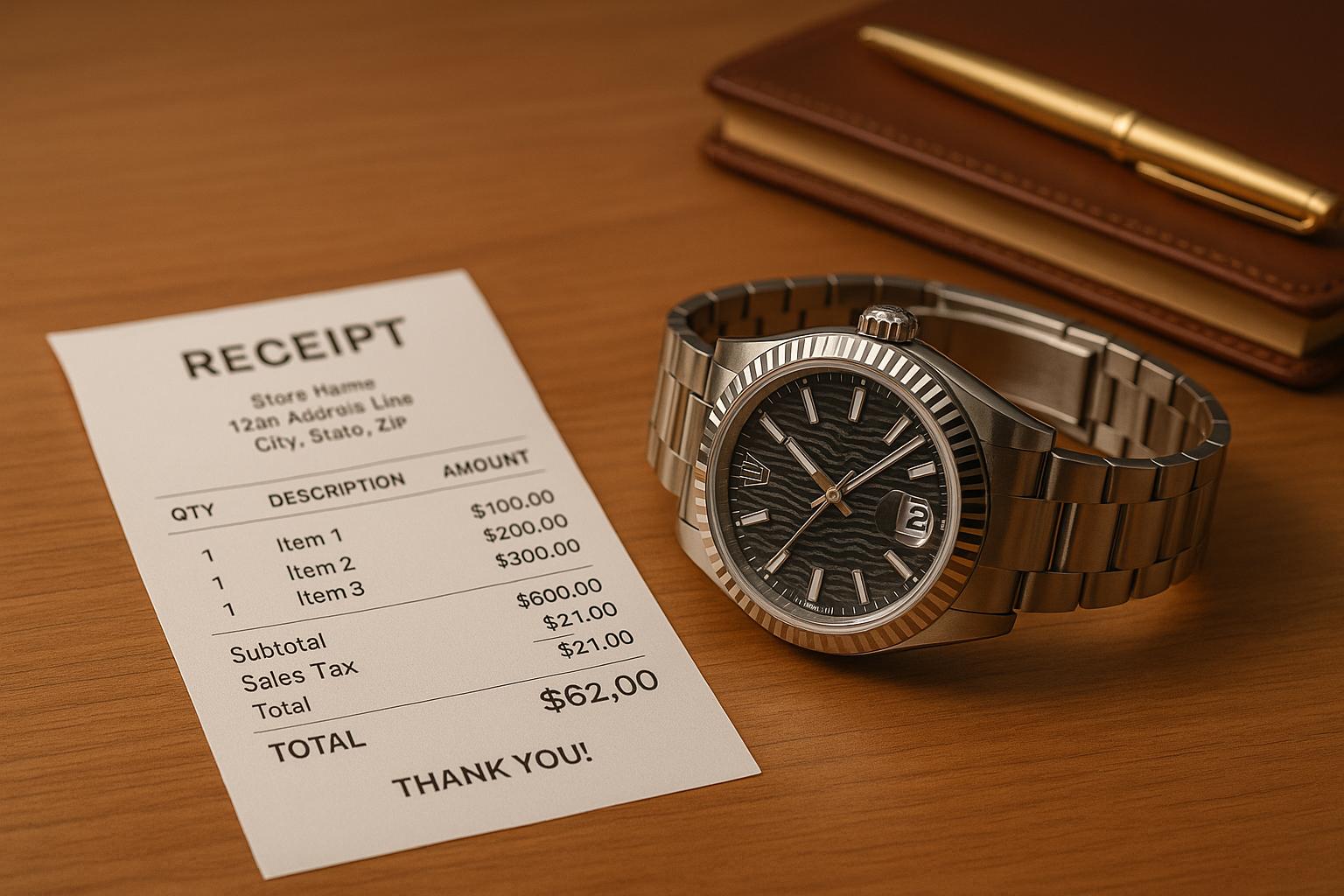Filing a watch insurance claim can seem overwhelming, but it doesn’t have to be. Here’s a quick guide to get started:
- Act Fast: Report theft or loss to the police within 24 hours.
- Document Everything: Gather proof of ownership (receipts, appraisals, photos) and incident details (written statements, witness info, police report).
- Check Your Policy: Review coverage limits, deductibles, exclusions, and deadlines.
- Submit Your Claim: Use your insurer’s portal, app, or hotline; provide all required documents and accurate details.
- Track Progress: Monitor updates via your claim number and stay in touch with your insurer.
Claims are typically resolved within 30 days if all documentation is complete. Preparing ahead with detailed records and understanding your policy can make the process smoother.
How Insurance Claims Work and How to Deal with Insurance Claim Adjusters
First Steps After Watch Loss or Damage
Acting quickly is key if your luxury watch is lost, stolen, or damaged. The steps you take right after discovering the incident can make a big difference in the outcome of your insurance claim.
File Official Reports
Report the loss or theft to the police within 24 hours. Be as detailed as possible when filing the report – include the brand, model, serial number, unique features, and any relevant details about the incident [3].
Document Everything
Thorough documentation is your best ally when filing an insurance claim. Here’s what you should gather:
| Documentation Type | What to Include | Why It’s Important |
|---|---|---|
| Photos | Clear images of damage under good lighting | Helps assess the damage visually |
| Written Statement | Date, time, location, and what happened | Establishes a clear timeline |
| Witness Information | Names and contact details | Provides additional support |
| Related Expenses | Receipts for temporary repairs or security measures | May qualify for reimbursement |
If your watch is damaged, hold off on repairs until you’ve spoken with your insurer. Attempting to fix it without approval could risk your coverage. Take clear, well-lit photos of the damage instead.
In cases of a lost watch, note the last place you remember having it and retrace your steps. These records will be essential for your claim and can help speed up the process [2][3].
Once you’ve gathered all the necessary documentation, the next step is to review your insurance policy to understand your coverage and claim procedures.
Check Your Insurance Policy
After documenting the incident, turn your attention to the key sections of your insurance policy that will affect your claim.
Policy Coverage Details
Your policy includes important details like coverage limits, deductibles, and filing deadlines. Here’s what to focus on:
| Policy Element | What to Look For | Why It Matters |
|---|---|---|
| Coverage Limits | Maximum payout amount | Ensures you’re covered for the full value |
| Deductibles | Out-of-pocket amount | Understand what you’ll pay before coverage kicks in |
| Claim Deadlines | Time limits for filing | Avoid having your claim denied for late submission |
| Required Documentation | List of necessary papers | Helps you gather everything needed to file your claim |
For luxury watches bought within the last 12 months, a proof of purchase might work in place of a formal appraisal [1].
Policy Limits and Exclusions
Knowing what your policy doesn’t cover can save you from filing claims that are likely to be denied. Common exclusions include:
- Normal wear and tear
- Issues from lack of maintenance
- Damage from unauthorized repairs
- Problems caused by improper care
- Restrictions tied to specific travel scenarios [2]
"Claims can be settled within 30 days of claim intimation, but this timeframe may extend if arbitration is involved" [2].
If your watch needs immediate attention, document its condition thoroughly and reach out to your insurer before starting any repairs. For frequent travelers, double-check that your policy includes international coverage and be aware of any limitations.
Consulting with a watch insurance specialist can make sure your policy is tailored to your specific timepiece [1].
Once you’ve reviewed your policy and understand its guidelines, the next step is gathering all the documents needed to back up your claim.
sbb-itb-fcc00bb
Required Claim Documents
Submitting the right documents is crucial for validating your claim and ensuring the process goes smoothly.
Key Claim Documents
Ownership Records
These documents confirm your watch’s value and prove ownership:
| Document Type | Purpose | Validity Period |
|---|---|---|
| Purchase Receipt | Confirms original cost and purchase date | Permanent |
| Professional Appraisal | Shows current market value | Up to 5 years |
| Authentication Certificate | Verifies the watch’s authenticity | Permanent |
| Serial Number Record | Links the watch to its owner | Permanent |
Incident Documentation
Accurate records of the incident can strengthen your case. Make sure to include:
- A detailed description of the incident, covering the date, time, location, and any witness accounts.
- Clear photos showing damage from multiple angles.
- A police report filed within 24 hours (for theft-related claims).
- Video evidence, if available.
Insurance Forms
You’ll also need to provide specific insurance documents:
| Required Form | Details to Include | Notes |
|---|---|---|
| Claim Form & Statement | Policy number, incident details, and a timeline of events | Complete all fields |
| Policy Certificate | Proof of current coverage | Include every page |
Note: Depending on your case, your insurer might ask for additional documentation.
Once you’ve gathered all the necessary documents, you can move forward with filing your claim and tracking its progress.
Submit and Monitor Your Claim
File Your Claim
You can file your claim using your insurer’s online portal, mobile app, or hotline. To make the process smooth:
- Fill out all forms completely: Double-check every field to ensure no details are missing, which could delay processing.
- Upload clear documentation: Use high-quality, easy-to-read copies of the required documents from earlier steps.
- Give accurate incident details: Include precise dates, times, and a clear description of the loss or damage.
After submitting your claim, it’s important to stay updated on its progress to avoid unnecessary delays.
Check Claim Progress
Claims usually follow a process: initial review, document verification, assessment, and settlement. If everything is in order, this can often be completed within 30 days.
To track your claim efficiently:
- Keep your claim number handy: You’ll need it for all communications with your insurer.
- Stay on top of your email: Most updates will be sent to you electronically.
- Document all interactions: Record dates, times, and the names of any representatives you talk to.
Many insurers offer online tools to help you monitor your claim through their customer portals. For direct updates, you can also reach out to your claims representative during business hours.
Conclusion: Next Steps
Key Takeaways
Filing a watch insurance claim successfully hinges on acting quickly, providing accurate documentation, and understanding your policy’s details. Essential actions include reporting any theft or loss to the police within 24 hours, collecting proof of ownership, carefully filling out insurance forms, and staying in touch with your insurer throughout the process. On average, claims are resolved within 30 days, although this timeline can shift depending on the complexity of the claim and the completeness of your documents [2]. Remember to review your policy annually and update appraisals every five years to account for market fluctuations [1].
Additional Resources
If you’re looking for more ways to safeguard your luxury watch, consider these helpful options:
- Chronoexpert‘s Knowledge Base: Offers in-depth guides on maintaining and protecting luxury watches.
- Insurance Provider Resources: Many insurers provide tutorials and checklists for filing claims.
- Professional Appraisers: Regular assessments by experts help keep your watch’s value up-to-date.
Prevention Tips
Keep detailed records of your watch collection, including appraisals, receipts, and photos. Staying organized can make the claims process much smoother.
FAQs
How do I submit a claim to insurance?
Most insurers offer multiple ways to file a claim, including:
- Online claims portal
- Mobile app
- Phone
- Fax
Submitting your claim quickly can help speed up the investigation and resolution process. While there might not be strict deadlines, acting promptly helps preserve evidence and ensures a faster outcome [2].
The method you choose can also affect how quickly your claim is processed. Digital options, like online portals and mobile apps, often make it easier to upload documents and track progress. On the other hand, calling might be better for more complicated claims that need detailed explanations.
Make sure to respond quickly to any requests from your claim examiner to avoid unnecessary delays. Knowing your options and staying on top of the process can make the experience much smoother [2].


